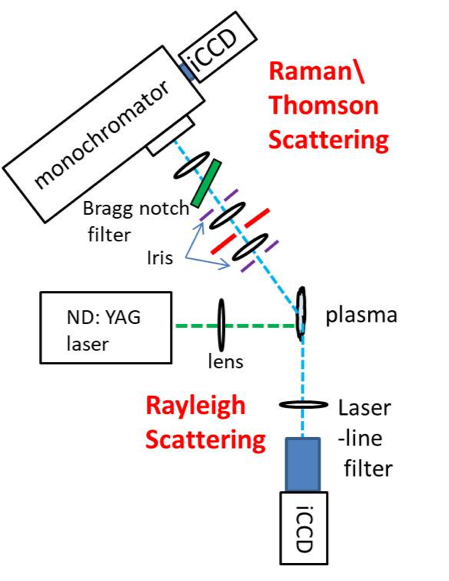Thomson and Raman Scattering

Laser Thomson scattering (LTS) is commonly employed to measure the electron density and electron energy distribution function (EDF), . The LTS signal is elastic scattering of laser beam on free electrons which is Doppler broadened due to the velocity of electrons. Recently the plasma density detection limit about 109 cm-3 was reported. For the plasma of interest, with and
, the resulting scattered LTS spectrum (known as incoherent) can be used to obtain plasma electron density and electron energy distribution function (EDF). To facilitate LTS diagnostics we will use the setup similar to described in Ref. . The laser (Continuum SL-III, operating at 532 nm, pulse length 8 ns, pulse energy 550 mJ, repetition rate 10 Hz) will be focused inside the plasma to a spot size of ~250 μm. We intend to use a volume Bragg notch filter in order to filter the strong Raleigh component from the scattered light. The filter is a reflecting volume Bragg grating (VBG) and is specified to block light with an optical density (OD) of 3–4 with a full width at half maximum (FWHM) of 5–8 cm−1 (≡0.14–0.23 nm). The transmission of the filter outside the blocking region is 80%. The reflected wavelength can be tuned by rotating the filter. Setting an angle of 6◦ between the filter normal and the direction of the incoming light results in the reflection of 532 nm light, which is the operating wavelength (λl) of the laser. The main drawback of the VBG filter is the small angular acceptance of less than
, therefore, adequate collimation of the scattered light is a key. The implementation of the VBG in the detection arm of the spectrometer is described below. First, the collected light is focused (focal distance f = 50 mm) on a pinhole to spatially filter out which the light is collimated using a second lens. Hereafter, the VBG is positioned to rejected light at
. The remaining light is focused into an optical fiber which is connected to the monochromator (iHoriba 550) after which the signal is detected by an intensified CCD camera (Andor, iStar). Irises are used to decrease the amount of stray light from the reactor. In nitrogen-rich atmosphere of the arc rector the Thomson and Raman signals contribute to the collected spectrum. To fit measured spectrum, the Raman contribution will be calculated in custom made Matlab code when the Rayleigh signal (recorded without mask in TGS) will be used to obtain instrumental profile. The Raman spectrum fit will provide the gas temperature . This procedure will allow separating the signals and obtaining Thomson component. To facilitate absolute electron density measurements the calibration of the LTS setup will be done by Raman scattering in nitrogen gas.